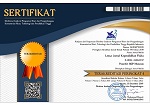PENERAPAN MODEL PEMBELAJARAN INKUIRI TERBIMBING BERBASIS LABORATORIUM DAN PENGARUHNYA TERHADAP HASIL BELAJAR FISIKA PESERTA DIDIK SMA NEGERI 8 MATARAM
DOI:
https://doi.org/10.33394/j-lkf.v1i2.205Keywords:
Guided Inquiry learning model based-on Laboratory, Cognitive learning outcome, psychomotor learning outcomeAbstract
This study aims to determine: (1) The effect of guided inquiry learning model based on real laboratory and virtual laboratory on students' cognitive learning outcomes; (2) Effects of guided inquiry learning model based on real laboratory and virtual laboratory on students' psychomotor learning outcomes. The study sample consisted of the first experimental class of 34 students and the second class of 33 students. This research used randomized post-test control group design. Data were analyzed using independent sample t-test statistic technique with SPSS 19 for windows. The result of statistical analysis at 5% significant level shows: (1) the t-test value for the cognitive domain of -2.407 at sig.0.019; (2) the t-test value for the psychomotor domain is -5.595 on the sig. 0.00. However it can be concluded: (1) There is a significant difference in the cognitive learning outcomes of physics learners using guided inquiry based inquiry model based on real laboratory and virtual lab; (2) there is a significant difference in psychomotor learning result of physics learners using guided inquiry model based on real laboratory and virtual lab.
References
Arends, R.I. 2008. Learning to Teach. Edisi Ketujuh, Buku Dua. Terjemahan oleh Soetjipto, HP. & Soetjipto, SM. 2008. Yogyakarta: Pustaka Pelajar.
BSNP. 2006. Standar Isi untuk Satuan Pendidikan Dasar dan Menengah. Jakarta: BSNP
Eggen, P., & Kauchak, D. 2012. Strategi dan Model Pembelajaran: Mengajarkan Konten dan Keterampilan Berpikir, Edisi Keenam. Terjemahan oleh Satrio W. Jakarta: PT. Indeks.
Finklestein, N.D., Adams, W.K., Keller, C.J., Kohl, P.B., Perkins K.K., Podolefsky, N.S., & Reid,S. 2006. When Learning About the Real World is Better Than Virtually: A Study of Substituting Computer Simulation for Laboratory Equipment. Physical Review Special Topics-Physics Education Research 1, 010103 (2005).
Fraenkel, J.R., & Wallen, N.E. 1993. How To Design and Evaluate Research. New York: McGraw-hill inc.
Gredler, M.E. 2011. Learning Instruction: Teori dan Aplikasi, Edisi Keenam. Terjemahan oleh Tri Wibowo. Jakarta: Kencana Prenada Media Group.
Jacobsen, Eggen, P., & Kauchak, D. 2009. Methods For Teaching. Terjemahan oleh A.Fawaid & Khoirul A. Yogyakarta: Pustaka Pelajar.
Joice, B., Weil, M., & Calhoun, E. 2009. Models of Teaching. Terjemahan Oleh Mirza A. & Fawaid A. Yogyakarta: Pustaka Pelajar.
Liliasari, Abdurrahman, Rusli, A., & Waldrip, B. 2011. Student’s Representations Preference in Learning Physics and “Thematic Pre-Conceptions†in Quantum Physics Concept . Proceeding of the Third International Seminar on Science Education “Challenging Science Education in The Digital Era†ISBN: 978-602-8171-14-1
Mulyasana, D. 2011. Pendidikan Bermutu dan Berdaya Saing. Bandung: Remaja Rosdakarya.
Rapi, N.K. 2008. Implementasi Model Pembelajaran Inkuiri Terpimpin dalam Pembelajaran Fisika untuk Meningkatkan Hasil Belajar pada Siswa Kelas X SMA Negeri Singaraja. Jurnal Pendidikan dan Pengajaran UNDIKSHA, No.1 Th.XXXXI :170-185.
Sisdiknas. 2012. Undang-Undang Republik Indonesia No.20 Tahun 2003 Tentang Sistem Pendidikan Nasional. Jakarta: Diva Press.
Wieman, C.E., Adams,W.K., Loeblein,P., & Perkins,K.K. 2010. Teaching Physics using PhET Simulation. The Physics Teacher. Vol.48. DOI:10.1119/1.3361978.
Wiyono, K. & Taufik. 2011. Using Computer Simulation to Improve Concept Comprehension of Physics Teacher Candidates Students in Special Relativity. Proceeding of the Third International Seminar on Science Education “Challenging Science Education in the Digital Era†ISBN: 978-602-8171-14-1.
Downloads
Published
How to Cite
Issue
Section
License
Authors who publish with Lensa: Jurnal Kependidikan Fisika agree to the following terms:
- For all articles published in Lensa: Jurnal Kependidikan Fisika, copyright is retained by the authors. Authors give permission to the publisher to announce the work with conditions. When the manuscript is accepted for publication, the authors agree to automatic transfer of the publishing right to the publisher.
- Authors retain copyright and grant the journal right of first publication with the work simultaneously licensed under a Creative Commons Attribution-ShareAlike 4.0 International License that allows others to share the work with an acknowledgment of the work's authorship and initial publication in this journal.
- Authors are able to enter into separate, additional contractual arrangements for the non-exclusive distribution of the journal's published version of the work (e.g., post it to an institutional repository or publish it in a book), with an acknowledgment of its initial publication in this journal.
- Authors are permitted and encouraged to post their work online (e.g., in institutional repositories or on their website) prior to and during the submission process, as it can lead to productive exchanges, as well as earlier and greater citation of published work (See The Effect of Open Access).

This work is licensed under a Creative Commons Attribution-ShareAlike 4.0 International License.



